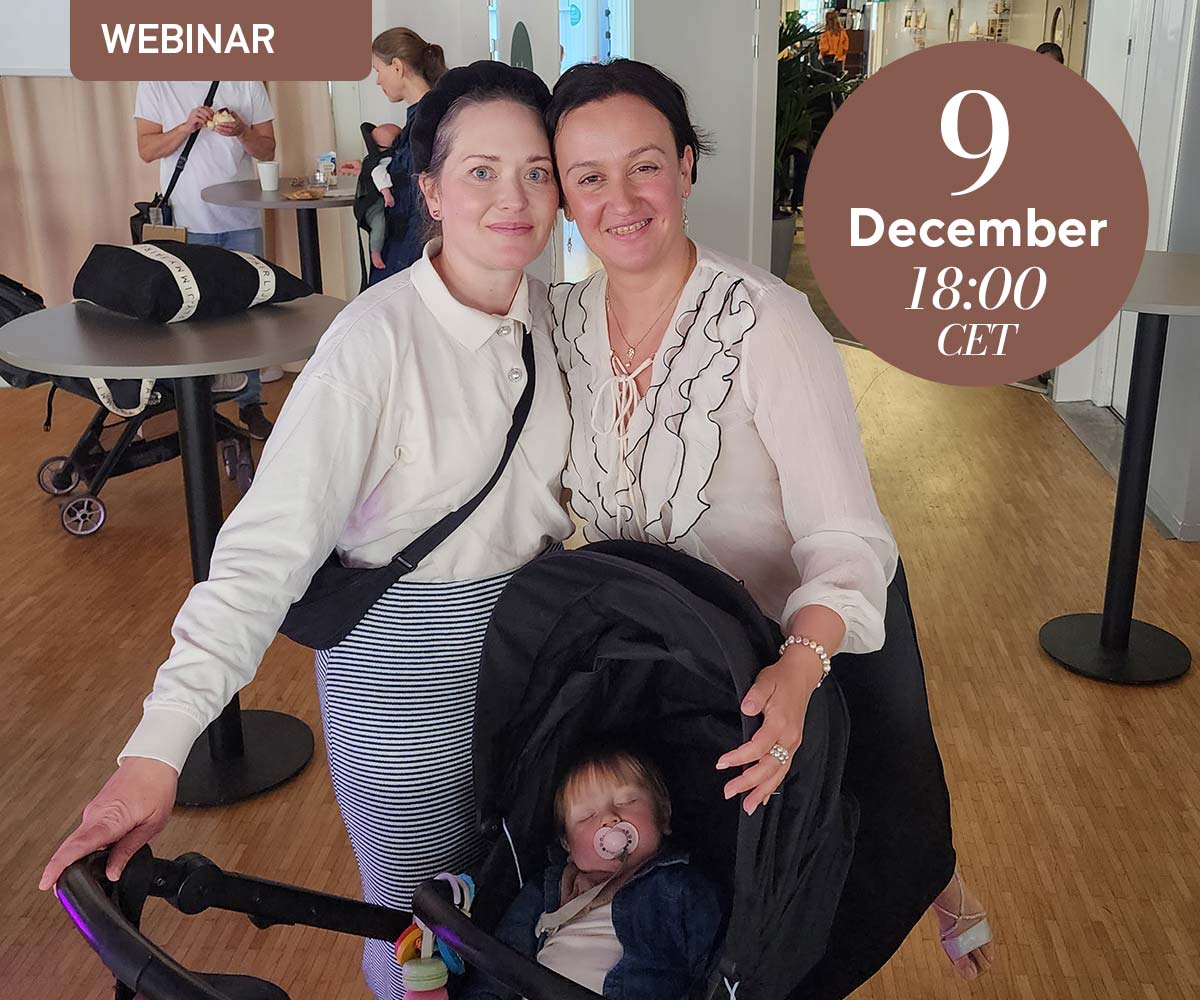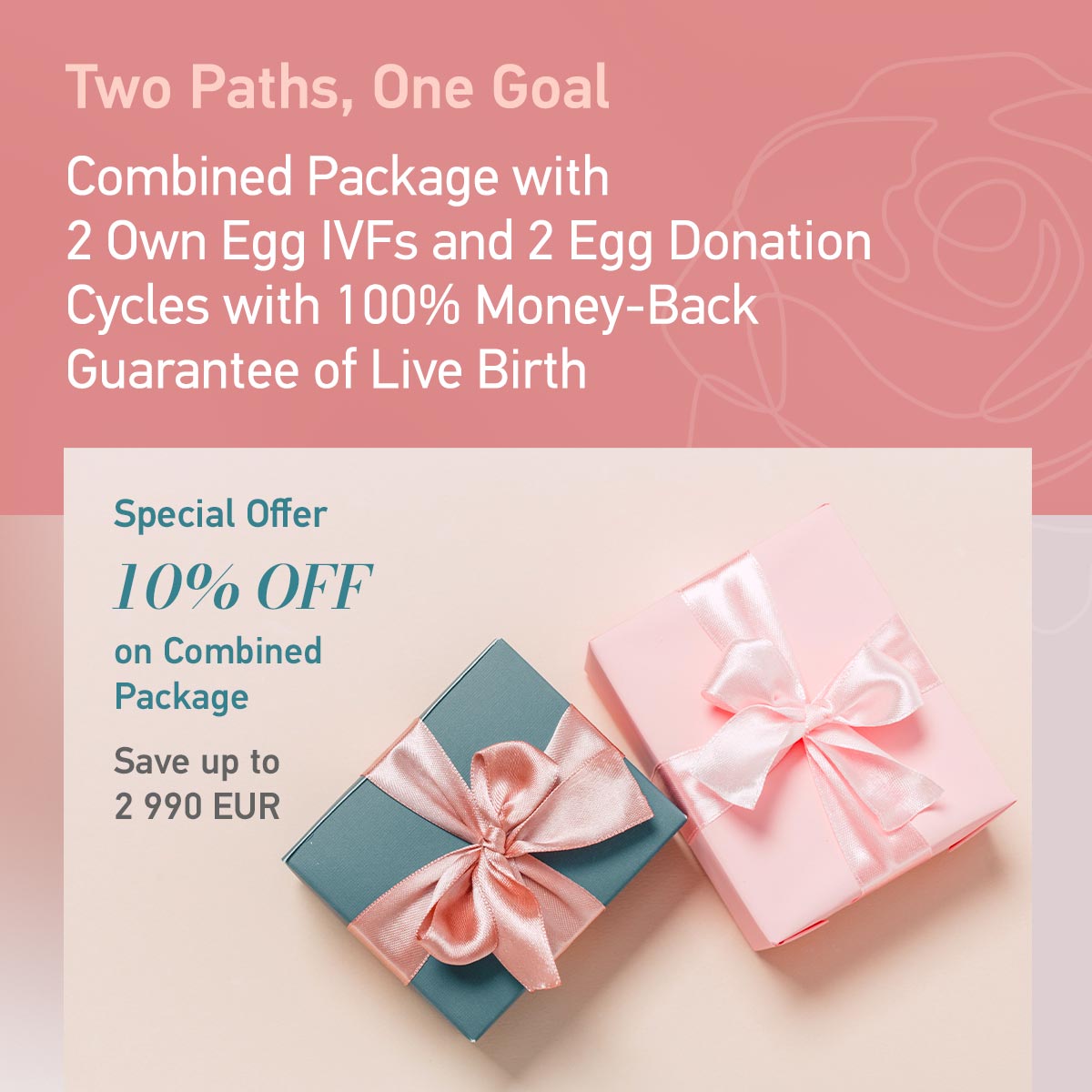
By Anna-Maria Stawreberg, photo: Anna Rut Fridholm. Tara magazine, December 2018, Sweden
Cilla Holm's longing for a child of her own came late in life. Too late, many think. She spent a lot of time and money to help nature – until one day she came in contact with embryo adoption. Now the baby is here, a little girl who will know that her way to Cilla began with donors in Russia.
When we meet, the baby is not yet here. Cilla Holm breathes heavily while walking through the café where we are to meet. But only after having sent a text saying that she will be late because she no longer moves as smoothly as before.
It's not strange. She is pregnant in week 37, and the baby in her belly has already made it clear that it would like to come to the world a bit earlier than planned.
“I love every pregnancy ailment. Every single pregnancy symptom I have had during these 37 weeks I think was lovely. I think it is nice having to go up at night and pee, yes, I have even welcomed pregnancy nausea,” says Cilla with a humorous glimpse in her eyes.
Cilla has longed for getting pregnant. Long. And it has cost her, in time, energy and money.
“For many years I was sure I would not have children because I was convinced that I would be a bad mom,” says Cilla and puts down the tray with yogurt, sandwich, egg, latte and lemonade on the low table in front of her.
She wrestles down in the even lower armchair and gets ready to tell.
Cilla had for a while the privilege of being a bonus mom and it made her reconsider. She realized that she might be a good mom.
“So, when I was around 35 the longing for a child of my own awoke. The problem was that I lived in relationships with men who were done with children,” says Cilla.
Cilla did like the ostrich: She put her head in the sand and forced away every thought of having children. At least until she was 40. It became like an alarm clock, and she was struck by the insight that she did not have all the time in world. Would she ever have a chance to become a mom, it was about time now. Or as she says today: It's stupid to wait that long, physically the prerequisites to getting pregnant diminish markedly already from about 30.
“In the beginning, I was afraid to try to be a mother on my own. I was thinking about different options to become pregnant, and rejected them one by one. The thought of shared parenthood, that is, trying to have children with someone else who also wants to be a parent, did not work. And adoption was no option because I was too old and single.”
In Cilla's world one alternative remained: insemination in Denmark. She felt that time was running out, and decided to act quickly.
So Cilla crossed the Sound and underwent in total five inseminations during spring 2016. It failed. Cilla decided to pause over the summer, since the constant failures made her tired psychologically.
But when autumn came she started again. Cilla did not give up and now shifted to IVF. She had decided to get pregnant, and quickly made five IVFs. Also these failed.
“In retrospect, I regret that I did not go for IVF right away, it would have been easier, but at that time I did not know this, but thought that insemination was the smartest and easiest option,” says Cilla.
Cilla simply did not get pregnant. The doctors found no physical problems, so why it did not work she did not know, more than that it had something do to with her age.
“I became obsessed. Once you have started trying to get pregnant it is almost impossible to stop. It is just as if a third party has to put an end to it,” says Cilla.
If she had been tired earlier, that was nothing to what she was now.
“I was fat, swollen, pumped with hormones, had an okay mood, but was exhausted – and on the verge of being ruined. I decided to take another summer vacation from trying to get pregnant. I needed time to accept my situation and recover with sun and bath.”
Cilla worked full time as project manager and studied to become a therapist during this period. Somewhere within her she realized that she did not have the economy to continue, but she could not stop. She had budgeted for the fertility treatment to cost her 50 000 Swedish crowns. It landed over 450,000 SEK.
“In the end, my Danish doctor and also my Swedish gynecologist said I had to move on. They told me about Olga Zaytseff and the clinic in St. Petersburg.
Cilla was skeptical, yet decided to attend one of the clinics' seminars that were organized in Stockholm in spring 2017. It was here she heard about the possibility of becoming pregnant with either egg donation or embryo adoption, something the clinic recommends women who are in their 40ies. For Cilla as a single, embryo adoption was the option.
At the beginning, Cilla pushed away the thought. She wanted a child from her own eggs. Not a child who came out another woman's fertilized egg.
“Today, I can’t understand why I reasoned that way, since genes were not important to me from the beginning, I mean, I did consider adopting. After having discussed the options with the doctors from the clinic I realized the benefits of making an embryo adoption, that is, having an embryo inserted,” says Cilla.
Cilla was assisted by the clinic with suggestions of egg donors and sperm donors – as it felt elitist to select by browsing their database. The final choice was an egg donor with an appearance like hers, and a sperm donor who resembled her ways.
“This help felt nice to have, because they have done this so many times. I trusted their experience.”
Then everything went fast. One flight with subsequent visits at the clinic in St. Petersburg later she was pregnant and it is this little miracle that now kicks in Cilla's stomach.
After that, the Swedish traditional maternity care took over.
She has read a lot about how she will tell the child about how it came to be. Certainly, she is the biological mother, but she's not a genetic mother to the child.
“I have decided that already when the child is newborn I will tell. Every day, when I change diapers, I will tell how I became a mother with the help of someone else's eggs and donated sperm. In that way it will be natural and not dramatically when the child is getting older. Since Cilla is not the genetic mother the child will eventually need to learn that there are other genetic parents. Who the genetic mother is the child is not allowed to know, but the sperm donor is an open donor so that Cilla's child as an adult can find out who it is.
However, it may be important to keep track of your donor numbers or similar identification, not least if a donor child is dating another donor child later in life.
During the years longing for children Cilla has become somewhat an advocate for people who long for children and want to become parents in a non-traditional manner. In the pod "I want children" she and her colleague, freelance journalist Annika Leone, speak about involuntary childlessness and various unconventional solutions. That the interest is enormous, she notices from all the emails she receives.
“I have almost only received positive reactions to my decision to become a mother on my own. I'm lucky to have a large network around me, and a 14 people strong support group that will help me in the beginning with the newborn.”
After Cilla became pregnant she met a guy with whom it is serious. He is engaged, but will not participate at the childbirth. Instead, Cilla’s two best friends have the honorable mission.
“One is a midwife. The other has given birth to four children. So, I feel I'm in safe hands,” notes Cilla.
“50 percent become mothers at the first attempt”
Russian doctor Olga Zaytseff helps Swedish women become pregnant up to the age of 51. "Sometimes you have to give nature a helping hand" she says.
The seminar room in Stockholm is stuffed with expectant women and men. It smells of freshly baked buns and coffee. At first glance, it feels like an opening of some kind, but the folders on the many chairs reveal that this is something completely different. Instead of photographs on artwork there is a photo of a woman sleeping close to a newborn baby.
A lot of people have come here to know more about their chances of having a baby in their arms.
Doctor Olga Zaytseff, who holds the seminar, has good insight into what it means to long for a child. Over the years she has met many people who want nothing rather than becoming parents. But she also had the great joy of helping thousands of women actually getting pregnant.
“Being unable to conceive is a source of great pain, and it raises a wide range of questions and a feeling of both incapability and guilt,” she says.
In the almost two hours long lecture she tells about the AVA-clinic, and out of the audience’s initiated questions, it is noted that many have been in the "longing-for-children situation" a long time.
The clinic works in several ways, which method is used has to do with the egg quality. Sometimes IVF is enough, but women over 43 are recommended egg donation. If she passed 44, egg donation or embryo adoption with donated eggs and donated semen, is applicable.
After a first telephone meeting, an ultrasound examination is performed by the woman's Swedish gynecologist, where the ovaries and uterus are controlled.
Then a Skype meeting is booked where a treatment plan is created. This is where Olga Zaytseff and her colleagues along with the woman discuss whether the next step will be IVF with her own eggs, donated eggs or embryo adoption.
The woman and her partner, if any, choose egg donor and, if necessary, also sperm donor from the AVA-clinic register.
“The couple may choose donors freely from our registry, but we have a great experience and can help to choose.”
Usually only one visit to St. Petersburg is necessary, for the embryo transfer to the uterus.
“We always wait five days after fertilization before inserting the embryo. Many clinics are in too much of a hurry, which results in an increased risk of the embryo being ejected. With our method, 50 percent will become mothers already at the first attempt.”
The cost varies, but usually ends up around 100 000 SEK. The clinic also offers a "money back guarantee" where the woman gets 80 percent of the sum in return if no living baby is born.
When fertilization is done, the woman goes back to Sweden and the Swedish maternity care takes over.
Getting pregnant as older is not an obstacle, according to Olga Zaytseff.
“Socially, there is nothing strange with having children late. But the woman's eggs are the same age today as they were during the Stone Age. Here you simply have to give nature a helping hand...”

























Comments are closed.